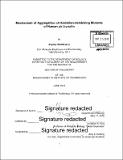| dc.contributor.advisor | Jonathan A. King. | en_US |
| dc.contributor.author | Serebryany, Evgeny | en_US |
| dc.contributor.other | Massachusetts Institute of Technology. Department of Biology. | en_US |
| dc.date.accessioned | 2016-09-13T19:08:12Z | |
| dc.date.available | 2016-09-13T19:08:12Z | |
| dc.date.issued | 2016 | en_US |
| dc.identifier.uri | http://hdl.handle.net/1721.1/104170 | |
| dc.description | Thesis: Ph. D., Massachusetts Institute of Technology, Department of Biology, 2016. | en_US |
| dc.description | Cataloged from PDF version of thesis. "June 2016." In title on title page, "[gamma] appear as lower case Greek letters. Vita. | en_US |
| dc.description | Includes bibliographical references. | en_US |
| dc.description.abstract | Protein misfolding and aggregation is a ubiquitous challenge in biology and medicine. Among its many manifestations is age-onset cataract disease, the leading cause of vision loss. Cataracts arise from increased light scattering in the eye lens due to aggregation of the lens crystallins, misfolded because of various covalent modifications accrued over a lifetime. Such modifications include oxidation of Trp residues to more hydrophilic residues following exposure to ultraviolet light. Structural features of the aggregation precursors, the aggregated state itself, and the mechanisms of aggregation are not well understood. This thesis focuses on human [gamma]D crystallin, a [beta]-sheet rich, topologically complex two-domain protein that is abundant in the lens nucleus, associated with cataract by both genetic and proteomic data, and representative of the larger y-crystallin family. To mimic oxidative damage, we substituted its four conserved buried Trp residues, one at a time, with more hydrophilic amino acids and studied the mutants' aggregation propensity. Effects on aggregation were strongly position-dependent, with only Trp 42 and Trp 130 substitutions showing substantial aggregation under non-denaturing conditions. The aggregates were neither covalent nor amyloid, showed little exposure of hydrophobic surfaces, and formed without broad denaturation. They were, however, highly redox-sensitive. Computational modeling suggested, and experiments confirmed, that a non-native disulfide bond, between Cys32 and Cys4l, was required for the aggregation of W42Q/R mutants; this bond matches that suggested by a recent proteomic study of cataractous lenses. Modeling the partially misfolded intermediate resulting from this disulfide bond allowed us to propose a molecular mechanism of aggregation via N-terminal hairpin extrusion followed by [beta]-sheet completion with the C-terminal domain. To test whether mutant or damaged polypeptides may template aggregation of wild-type or undamaged ones in a prion-like manner, we examined aggregation in WT/mutant mixtures. Surprisingly, the result was "inverse prion" behavior: WT [gamma]D crystallin specifically promoted aggregation of its W42Q/R mutants without detectably coaggregating with them. Isolated WT N-terminal domain carrying the same Cys32- Cys4l disulfide templated mutant aggregation, but did not escape coaggregation. Interaction between the two domains may account for both the templating activity and the escape, leading to this unexpected aggregation mechanism. | en_US |
| dc.description.statementofresponsibility | by Evgeny Serebryany. | en_US |
| dc.format.extent | 132 pages | en_US |
| dc.language.iso | eng | en_US |
| dc.publisher | Massachusetts Institute of Technology | en_US |
| dc.rights | M.I.T. theses are protected by copyright. They may be viewed from this source for any purpose, but reproduction or distribution in any format is prohibited without written permission. See provided URL for inquiries about permission. | en_US |
| dc.rights.uri | http://dspace.mit.edu/handle/1721.1/7582 | en_US |
| dc.subject | Biology. | en_US |
| dc.title | Mechanism of aggregation of oxidation-mimicking mutants of human [gamma]D-crystallin | en_US |
| dc.type | Thesis | en_US |
| dc.description.degree | Ph. D. | en_US |
| dc.contributor.department | Massachusetts Institute of Technology. Department of Biology | |
| dc.identifier.oclc | 958132953 | en_US |
